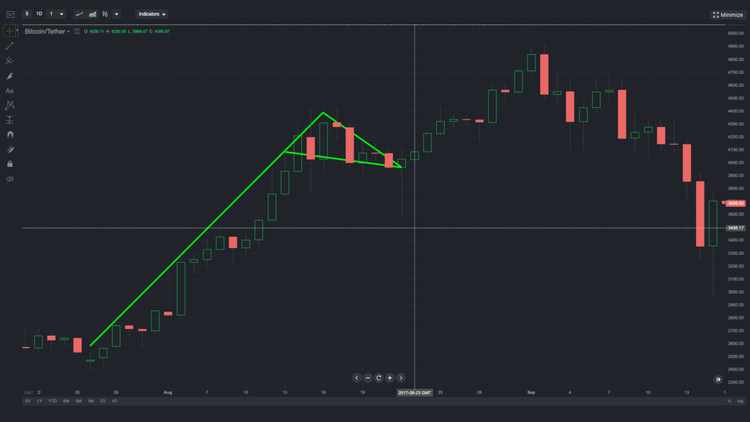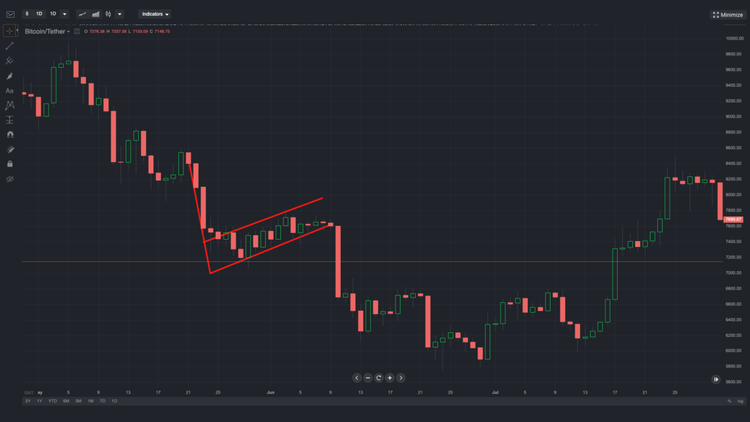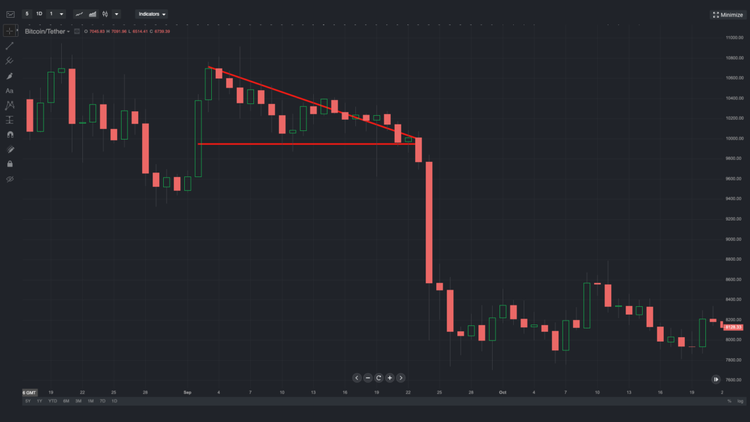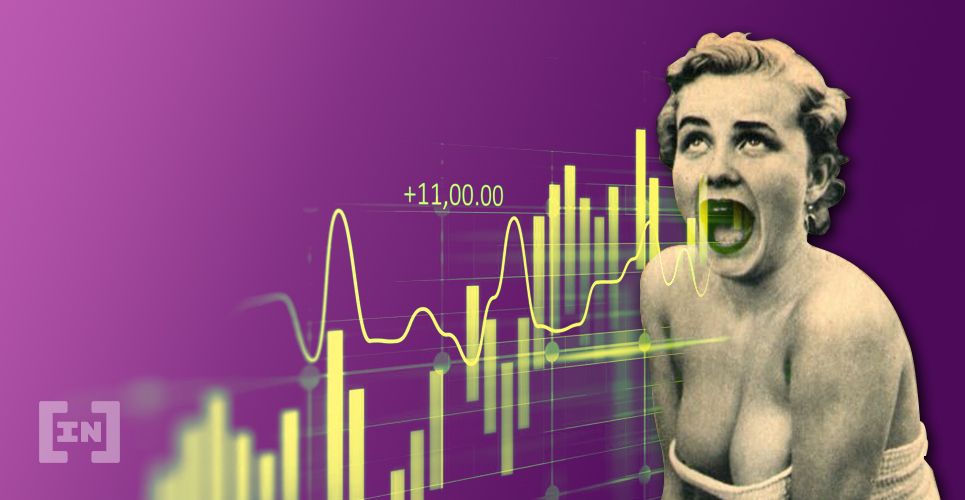When it comes to successfully making profitable trades, regardless of the current market conditions, the ability to identify trends is absolutely critical.
Despite this, however, many traders neglect to take advantage of the various tools many exchange platforms offer that help with predicting how the market will move. Likewise, because many traders rely on simply ‘eyeballing’ the market and reacting with their gut, losing money is commonplace.
Fortunately, with some basic technical analysis and charting, it is often possible to predict upcoming price action with reasonable certainty, helping traders not only make more profitable trade decisions but also better identify when to exit a losing position.
With that in mind, let’s take a look at some of the basic tools that you can find on any feature-packed exchange platform.
The Tools of the Trade
For the purposes of this guide, we will be using the charting tools available at StormGain, since this exchange features arguably one of the most comprehensive toolsets available and will likely feel familiar to anybody who has used TradingView. Depending on your experience as a trader and understanding of technical analysis, most charting tools will be immediately recognizable to you. For those with limited experience, we’ll break down the most popular tools and highlight what they are typically used for.Indicators
Indicators are built-in mathematical scripts that take the available market data and extract from it information that can be interpreted by the trader. They are typically used to gain insight into how the market has moved and might move in the future. StormGain and many other exchanges have dozens of pre-defined trends, oscillators, and volume indicators — understanding what each of these means can radically improve your trading profitability if used correctly.Bar style
Bar style is the tool used to change how the chart data is visualized. The right style can help with identifying trends and can also be used to spot trading opportunities that might be missed with other chart styles. For the most part, standard candles or hollow candles should suffice for the bulk of traders — but it wise to develop a familiarity with other styles too.Time interval adjustment
Time interval adjustment can be used to change the scale of the chart, allowing you to get a better picture of both the minute-to-minute price action and long term price trends. Looking at the charts on short-term timescales can provide excellent opportunities for quick profits, while longer timescales can yield incredible returns that have become characteristic of cryptocurrency markets.Trend lines
Trend lines are the swiss army knife of cryptocurrency traders and are arguably the most important tool used for predicting price trends. These are lines that are drawn over the peaks and valleys in a chart to gain an understanding of the prevailing price trend. As we’ll see, trend lines can be used to produce a variety of chart patterns that can be used to predict a bullish or bearish break.
Identifying Trading Opportunities
Now that we have a basic understanding of some of the tools on offer, we can start to take a look at some of the basic chart patterns that can be identified using them. It should be noted that these formations are rarely perfect — so don’t worry too much if your bull flag is slightly off, or your descending triangle is slightly skewed. What matters most is that the chart pattern fits the overall trend.Bullish Pattern: Bull Flag
Arguably one of the most iconic bullish chart patterns, the bull flag often precedes a sharp positive price breakout and is one of the easier patterns to recognize. A bull flag begins with the flag pole — which is a sharp positive trend that is interrupted by a short trend reversal, which forms the flag part of the chart pattern. Following a typically brief period of consolidation where the digital asset gradually loses value, the bullish trend will then be continued and lead to a further high above the peak of the flag pole. It is important to note that the flag part of the pattern can be either a relatively minor trend reversal or it can be a rather sharp reversal. Similarly, the flag part of the formation can be either rectangular or triangular. Technically, a triangular flag is known as a pennant, but either version can be considered bullish.
It is important to note that the flag part of the pattern can be either a relatively minor trend reversal or it can be a rather sharp reversal. Similarly, the flag part of the formation can be either rectangular or triangular. Technically, a triangular flag is known as a pennant, but either version can be considered bullish.
Bullish Pattern: Ascending Triangle
Another easily identified potentially bullish chart pattern is known simply as the ascending triangle. This formation is particularly common just prior to a strong bullish breakout and can often be spotted well in advance of any positive price action. This makes them suitable for those getting to grips with technical analysis for the first time. An ascending triangle is present when an asset is trading approximately horizontally in terms of peaks, but each low between successive peaks becomes gradually higher. In other words, the top flat part of the triangle indicates an area of resistance — whereas the base indicates a rising support line. Again, it should be noted that ascending triangles are rarely perfect. There will likely be some excess on either side of the triangle — but this doesn’t change the usefulness of the pattern.
Because a breakout can be expected towards the edge of the triangle, or shortly after, the best entry point is as close to the edge of the triangle as possible.
Again, it should be noted that ascending triangles are rarely perfect. There will likely be some excess on either side of the triangle — but this doesn’t change the usefulness of the pattern.
Because a breakout can be expected towards the edge of the triangle, or shortly after, the best entry point is as close to the edge of the triangle as possible.
Bearish Pattern: Bear Flag
Just as there are flag patterns that indicate a bullish trend, there is also a flag formation that indicates a potential bearish trend. This is known as the bear flag and is visible as an upside-down flag pattern on a chart. Bear flags begin with a sharp downwards candle that is broken by a period of a slight recovery. If the bear flag is accurate, then a second sharp decline should occur following completion of the flag — which should produce a low that is lower than the trough of the flag pole.
During particularly bearish markets, it is possible to have several back-to-back bull flags. This can cause substantial losses for investors — hence why setting a stop loss is a wise move.
In the case of a true bear flag, the ideal time to sell is at the start of the second bearish breakout (after the flag completes). This is also the best time to open a short position in this market.
If the bear flag is accurate, then a second sharp decline should occur following completion of the flag — which should produce a low that is lower than the trough of the flag pole.
During particularly bearish markets, it is possible to have several back-to-back bull flags. This can cause substantial losses for investors — hence why setting a stop loss is a wise move.
In the case of a true bear flag, the ideal time to sell is at the start of the second bearish breakout (after the flag completes). This is also the best time to open a short position in this market.
Bearish Pattern: Descending Triangle
As you might expect, since an ascending triangle is an indicator of a potential bullish breakout, a descending triangle is an indicator of an upcoming bearish break. Because of this, charting a descending triangle often means it could be a good idea to exit any long positions. As you can see by the above example, a bearish triangle is formed when the price action forms successive lower highs, whereas the lows between peaks stay roughly constant. This forms a triangle with a flat base and a descending slope.
If you happen to plot a descending triangle, then a significant move below the lower trendline can be the start of a downtrend — this is when you might want to open your short position.
As you can see by the above example, a bearish triangle is formed when the price action forms successive lower highs, whereas the lows between peaks stay roughly constant. This forms a triangle with a flat base and a descending slope.
If you happen to plot a descending triangle, then a significant move below the lower trendline can be the start of a downtrend — this is when you might want to open your short position.
Summary
Although an extensive array of chart tools and an understanding of basic chart patterns can definitely help improve your trading success, they are not an absolute guarantee of profitability — since the market can (and often does) move completely opposite to how it is expected to. Because of this, it is wise to make use of other available data to help with your decision-making processes — ensuring that you have as complete an understanding of the current market situation as possible before making trade choices. This can include making use of sentiment and technical indicators, as well as taking into consideration the current market climate.Disclaimer: This article is not trading advice and should not be construed as such. Always consult a trained financial professional before investing in cryptocurrencies, as the market is particularly volatile. StormGain is an exchange partner of BeInCrypto.
Disclaimer
In adherence to the Trust Project guidelines, BeInCrypto is committed to unbiased, transparent reporting. This news article aims to provide accurate, timely information. However, readers are advised to verify facts independently and consult with a professional before making any decisions based on this content. Please note that our Terms and Conditions, Privacy Policy, and Disclaimers have been updated.

Daniel Phillips
After obtaining a Masters degree in Regenerative Medicine, Daniel pivoted to the frontier field of blockchain technology, where he began to absorb anything and everything he could on the subject. Daniel has been bullish on Bitcoin since before it was cool, and continues to be so despite any evidence to the contrary. Nowadays, Daniel works in the blockchain space full time, as both a copywriter and blockchain marketer.
After obtaining a Masters degree in Regenerative Medicine, Daniel pivoted to the frontier field of blockchain technology, where he began to absorb anything and everything he could on the subject. Daniel has been bullish on Bitcoin since before it was cool, and continues to be so despite any evidence to the contrary. Nowadays, Daniel works in the blockchain space full time, as both a copywriter and blockchain marketer.
READ FULL BIO
Sponsored
Sponsored

